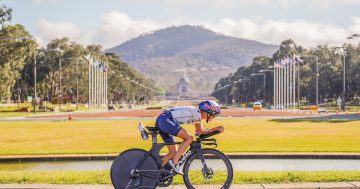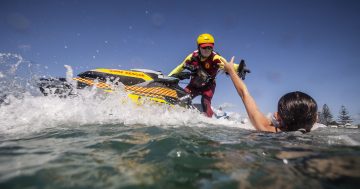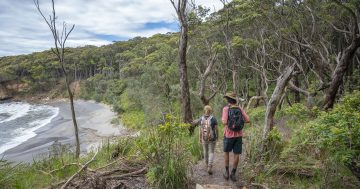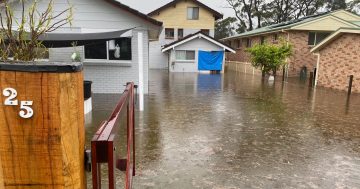
A surfer at Moruya Breakwall negotiates a large swell recently. Large waves will hit the coast again this weekend. Photo: Alex Rea.
A deep low-pressure system in the southern Tasman Sea and a tropical cyclone off the north Queensland coast are combining to cover the entire east coast in a 3 to 4 metre swell this weekend, prompting a hazardous surf warning and potential beach erosion on the NSW South Coast.
But the large swell has nothing to do with the series of earthquakes off the north-eastern coast of New Zealand, which prompted a tsunami warning for Norfolk Island on Friday (5 March).
The deep low-pressure system is the first this year to cross the southern Tasman Sea, bringing the majority of the big swell to the NSW coastline on Friday, Saturday and Sunday.
The swell is expected to reach heights of 5 to 6 metres offshore, while closer to the coastline, waves of between 3 and 4 metres are expected on exposed beaches on the South Coast.
A large high-pressure system over southern Australia will also make for clear and sunny conditions, providing a perfect combination for experienced surfers.
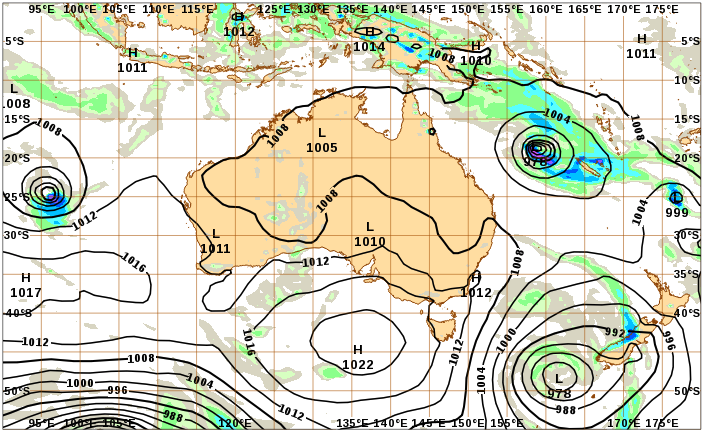
The deep low-pressure system in the Southern Ocean and tropical cyclone off North Queensland will bring hazardous surf conditions this weekend. Image: BOM
Swell forecaster with Coastalwatch Ben McCartney said a large pulse of south groundswell will emerge across Sydney, Newcastle and the South Coast at 14 to 15-second intervals on Saturday, before arriving across locations further north on Sunday.
“As the various models gradually pull together on the storm’s projected strength and track, we’ve seen the resulting south-swell potential steadily upgraded – and it’s now looking increasingly likely that a heavy south groundswell will impact the entire NSW coast this weekend,” Mr McCartney said on the Coastalwatch website.
The Bureau of Meteorology, Marine Rescue NSW and Surf Life Saving NSW joined forces to issue a hazardous surf warning on Friday (5 March).
“A deep low-pressure system crossing the southern Tasman Sea will bring a large swell to the NSW coast over the next few days,” said Bureau meteorologist Agata Imielska.
“Southern and central parts of the coast can expect a steady increase in swell during Friday afternoon and evening, creating hazardous surf conditions. On Saturday, the hazardous conditions will extend to the northern coast.
“The dominant swell during this event will be from the south. The significant wave height associated with this swell is expected to reach 3 to 4 metres, with a peak period of 13 to 14 seconds.
“The maximum wave height will be considerably higher. This combination of wave height and period will result in a very powerful surf.”
The NSW Police Force’s marine area command also advised people in areas affected by hazardous surf warnings to consider staying out of the water and avoid walking near surf-exposed areas.
“In the wake of a number of rock fishing fatalities this year, rock fishers should avoid coastal rock platforms exposed to the ocean and seek a safe location that is sheltered from the surf,” a NSW Police spokesperson said.
“Boaters planning to cross shallow water and ocean bars should consider changing or delaying their voyage. Those boaters who do choose to go out should carry the appropriate safety equipment and wear a lifejacket.”
The large swell coincides with the second weekend of the State Championships at Swansea-Belmont near Newcastle where more than 1100 elite surf and beach athletes represent 78 clubs from all 10 branches in NSW. The beach at Swansea-Belmont won’t get the full brunt of the predicted conditions due to the direction the beach faces and the protection of the island from big south swells.











